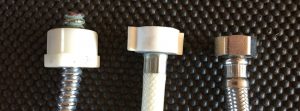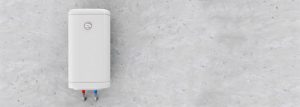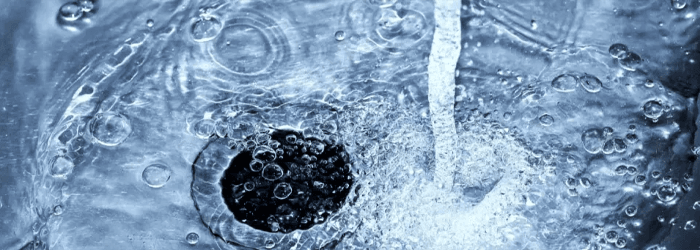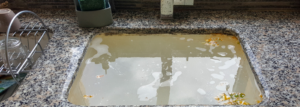DAY IN THE LIFE OF A PLUMBER
The throne. The porcelain goddess. The loo. No matter what you call the toilet, it needs to work when you do your business. So do the water heater and faucets. When they don’t work, leak, or are backed up, who do you call? A plumber – one licensed by the Arizona Registrar of Contractors.
Time To Call a Plumber
A plumber’s duties, for lack of a better word, is much more than unclogging a toilet or fixing a leaky faucet. A plumber installs and maintains pipes for potable water, drainage, irrigation, and sewage. They also install and repair water heaters and water filtration systems. They are involved in hands-on work and sometimes in a design capacity, drafting blueprints and helping make the installation process more efficient.
A local plumber notes the following most common plumbing issues:
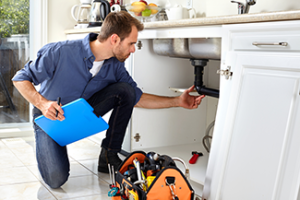
An overflowing toilet | Leads to a constant flow of water that can damage floors and carpet as well as the ceiling and rooms below if not stopped in time. Learn how to shut off your water until the plumber arrives.
Clogged drains | Don’t waste your time using chemical solvents as they are temporary and only slightly improve drainage in bathroom showers and sinks. A plumber can snake the drain and use a scope if the problem persists. Get it done right and you won’t have to worry about it for a long while!
Leaking pipes | Older homes or homes with weak connections need to be resoldered, fitted with new Teflon tape, or replaced need a professional plumber.
Bursting pipes | If your pipes burst, shut off the water immediately, and call your trusted plumber. Consider removing furniture and valuables. A damaged pipe can flood a home with more than 12-gallons of water a minute. SimpleSENCE Water Leak & Freeze Detector will alert you when home flooding occurs. A few well-placed sensors can help save your home from damage. Wifi is required.
Water heater issues | A damaged water heater can literally explode and shoot through the ceiling or turn into a rocket. This can happen whether a water heater is gas or electric. This happens when the pressure relief valve won’t open, and the thermostat won’t turn off. For gas water heaters a plumber will also check the integrity of all natural gas piping and fittings. Check out Myth Busters, episode 89.
Sump pump troubles | Years of wear and tear can take a toll on a sump pump. Do you really want to clean that up yourself?
Backed up sewage system | If you suddenly see an overflow of foul-smelling brackish water coming out from the seams of your walls, call a plumber immediately.
Perhaps don’t wait for an emergency, schedule annual maintenance with your plumber to ensure everything is running smoothly and anything that could be a problem is addressed before it becomes a disaster. The demand for all residential services is very high . Choosing a good plumber for regular maintenance will make it easier to get help when an emergency arises.
When the plumber visits ask them to show you how to turn off the water at the faucets, toilets, and the whole house. Also, have them check the water pressure to your home, it should be approximately 60 psi. A higher pressure can cause problems and void warranties on plumbing fixtures. It would be a good time to have your water heater drained as well.
What it is like to be a professional plumber.
 Matt Sears, department manager for electrical and plumbing at Temperature Control Inc., a Rosie-Certified Partner, takes us through a typical day for a plumber:
Matt Sears, department manager for electrical and plumbing at Temperature Control Inc., a Rosie-Certified Partner, takes us through a typical day for a plumber:
6:30AM | Their day starts at 6:30 in the morning when they arrive at the yard. They sort the jobs for the day, which could be two to six depending on the type of work, and make sure everything they need for each one is on their truck. For the smaller jobs, such as a leaky faucet, backed-up toilet or water heater replacement, all the equipment they will need is generally on their truck. Occasionally the plumber may need to run out to a supplier for a part during the job.
7:45AM |The plumbers are out the door by 7:45 a.m. and head to their first appointments, but not before giving treats and pets to the yard dog, “Blue” (pictured).
Not every call is a backed-up toilet or leaky faucet. Sometimes there is a repipe, a water heater replacement, or the installation of a water filtration system. Jobs such as those may require the plumber to be on-site for eight to 10 hours and their only call for the day. Installing a new toilet generally takes two hours.
4:00 – 6:00PM | “Most plumbers are done for the day between 4:00 p.m. and 6:00 p.m.,” says Matt. “They may finish as late as midnight if there is a problem such as getting the water back on, the toilets to flush, or other mechanical failures beyond what was visible at the initial sales call.”
Homeward Bound but On Call | When the plumber is done with their last job of the day, they head directly home. If they get home before 6:00 p.m. and a call comes in, they head out again. Calls that come in after 6:00 p.m. are serviced by the on-call emergency plumber. Every seven days, a different plumber within the company is on call. This is in addition to their regular work schedule.
So that’s where it went!
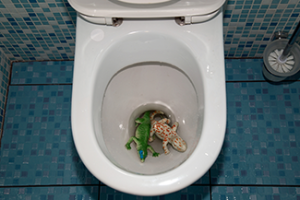 Plumbers see an uptick in calls between October and February. During that time, water heaters tend to be pushed to their limits and failure point. There is an additional uptick just before the holidays when homeowners want to ensure the plumbing is properly functioning before they have an influx of guests. Then there is a short-lived slow-down as the holidays approach because people don’t want a project happening during that time.
Plumbers see an uptick in calls between October and February. During that time, water heaters tend to be pushed to their limits and failure point. There is an additional uptick just before the holidays when homeowners want to ensure the plumbing is properly functioning before they have an influx of guests. Then there is a short-lived slow-down as the holidays approach because people don’t want a project happening during that time.
A plumber never knows what they might find when snaking a toilet. Matt has pulled up cotton swabs, candles, candle wax (which turns into a big glob), and toys. “Kids drop a lot of action figures in the toilet,” he muses. Our staff writer noted that her father flushed his mother’s diamond engagement ring down the toilet when he was three years old. Fortunately for him, the building’s superintendent caught it before it passed through the trap and into the Brooklyn sewer system. She credits the superintendent for her existence today.
Plumbing is what it’s “cracked” up to be.
Most of the plumbers at Temperature Control have at least five years of experience before joining the team and were able to run 95 percent of the jobs by themselves. Occasionally someone with three years will come along who learns quickly.
Plumbers can experience a great career in the service industry. There is a steady demand for their work and the pay is above average for the trades.
“Temperature Control is always on the lookout for skilled plumbers who want to show up and work hard”, says Matt. It is likely many other companies are too. So, what does it take to become a plumber? Indeed.com offers some advice.
Plumbers must be knowledgeable and adept at using various machinery and tools. Choosing appropriate tools and machinery ensures projects are completed efficiently, effectively, and safely. Additionally, plumbers may need to troubleshoot issues on the job by using tools and equipment creatively. Understanding how to manipulate physical objects is important for a hands-on career like plumbing.
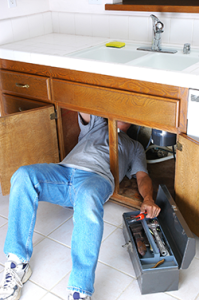
Plumbing can be a physically demanding job, requiring these skills:
- Flexibility: Plumbers reach areas that are often under cabinets, underground, and in other tight places.
- Good vision: Good eyesight is needed to work in dark spaces and with small, specialized tools and equipment.
- Physical strength: Carrying large pipes, keeping equipment and tools steady for long periods, and tightening clasps and fittings requires physical strength.
- Fine motor skills: Plumbers work with small tools and parts. Well-developed fine motor skills are needed to place, fasten, and operate these elements effectively.
- Problem solving: Identifying problems, diagnosing the cause, and providing solutions quickly while in the middle of a project is essential. This requires swift, logical reasoning and sometimes creative thinking.
- Basic computer skills: In addition to hands-on work, plumbers should be able to use basic computer programs, such as word processing and spreadsheet programs, plus any company-specific programs or software, such as project management or budgeting programs. Working knowledge of any computer programs commonplace in the industry is helpful.
- Physical sciences and math skills: The basic principles of water pressure, movement, physics and geometry are needed to develop project plans, calculate measurements and specifications, and problem-solve.
Plum Good Fun Facts
The flushing toilet was invented by John Harrington in 1596. His name lives on as the toilet is also known as “the John.” Likewise, we have “the crapper” thanks to Thomas Crapper, who widely increased the popularity of the toilet.
We can’t end an article about plumbers without mentioning the stereotypical plumber’s crack – the image of a heavyset plumber bent down beneath a sink with a tool belt around the waist, pulling down the back of the pants and exposing a backside nether region. This exposure has been called “builder’s bum” in the UK since 1988 and “plumber’s crack” in the U.S. as early as 1992. Despite the image, this term is actually about the 1990s fashion trend of tight-fitting, low-rise pants.
We could make some more wisecracks, but we’re going to pull up our big boy pants and move on.
PODCAST
We discuss a day in a life of a plumber and why it’s worth considering a career in plumbing. We also chat about products found at The National Hardware Show. Plus, listener questions on water softeners, cleaning duct work, a home extension involving a load bearing wall, and what creature was found in a toilet..!!
###
Photo Credit
- Temperature Control Inc.
- Shutterstock




